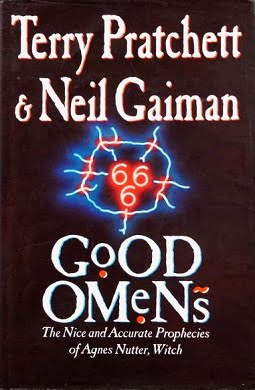Title: Good Omens
Author: Terry Pratchett and Neil Gaiman
Good Omens Rating: ⭐⭐⭐⭐
Introduction
You are not reading a review – it is a literary analysis. I shall assume you have read Good Omens. If you have not, please do so before you read further. It’s a short, easy-to-read book. More importantly, it is a good book (whoops, a spoiler!)
There are considerable spoilers here. Most are in the “Characters” and “Theme” sections. The “Plot, Pacing, and More” section should lack significant spoilers. Still, I take no responsibility for spoilers – I have warned you!
If you do not wish to read the book, you might watch season one of the Prime show. It is a very accurate adaptation of the book. There are some differences. I will cover some of them in the “Differences Between the Novel and the Series” section.
As literary studies go, this is short. I cannot cover every character, theme, or plot point. I will analyze what I consider the most compelling aspects of the book. If you wish to add to my analysis, leave a comment.
Without further ado, I will start my analysis of Good Omens!
Plot, Pacing, and More
Most of the book’s events occur on Armageddon Day. An eleven-year-old boy brings about the world’s end. It is a day predicted by one Agnes Nutter, allegedly the world’s only true prophet.
It is a day thousands of years in the making and opposed by almost nobody. The forces of heaven and hell certainly do not oppose it. A small part of the scant opposing forces is an angel and a demon best friend duo.
There might be a million Armageddon novels. However, I found this version refreshing, compelling, and rather amusing.
It reads more like a Pratchett novel than a Gaiman novel. Perhaps that is because Gaiman’s wittiness blends well with Pratchett’s style of humor. Or, perhaps, as I am more of an experienced Pratchett reader than a Gaiman reader, I noticed more of the Pratchett style.
It bears much of the humor typical of a Pratchett novel. Gaiman’s whimsical wit is abundant. The atmospheric and eerie writing style of Gaiman blends in so well with the weird and compelling writing style of Pratchett.
The plot gets going rather fast, with relatively little setup time. Good Omens thrusts us into Armageddon early on. Many events occur, especially since most of the book happens in one day, with a significant amount in the latter half.
The novel is fun – sometimes a little too fun. Important, compelling scenes sometimes cut away to arguably unnecessary or ill-placed scenes. That creates several pacing issues. However, this is nothing serious, and they do not significantly impact the flow of the novel.
For instance, it spends time on hilarious moments that seem out of place. Most of the moments with the Four Horsemen are examples of such scenes. Some such scenes are rather humorous. However, they seem unnecessary. Some seem somewhat drawn out.
Multiple factors swiftly converge towards the rushed end. You expect more than what happens – and then it ends almost abruptly. Despite this, the ending is compelling. It makes sense and is consistent with the book’s themes. However, it is hard to deny that it is a little rushed. It is hard to deny that elements of the ending do not seem necessary.
The nuclear and ecological Armageddon is predictable. That makes sense, given its 1990 publication date. All the same, the ending is predictable. I saw much of it coming from several miles away. Perhaps the way the world is ending is not surprising. The world is ending. Why not use this as an excuse for commentary about pollution and nuclear technology? Never mind whether these are credible concerns. The authors think they are. Although, their points are a little ham-fisted.
However, none of these issues prevented me from enjoying the book. Despite its pacing and other issues, the plot is brilliant, entertaining and tackles some compelling themes.
Characters (Spoilers)
The main characters are Aziraphale, Crowley, Anathema Device, Newton Pulsifier, Shadwell, Madame Tracy, Adam, and Adam’s friends, The Them. The Them dominate the story, have some of the most impact on the story, and are central to the novel’s themes.
I rather liked Aziraphale and Crowley. The latter might be a demon. However, he doesn’t show much commitment to the demonic routine. He loves Earth enough to be a sympathetic character. Crowley has spent considerable time here. He loves watering plants and driving his Bentley. He enjoys listening to the Velvet Underground and everything.
Aziraphale might be an angel. However, he is not enough of a boring choir-going Gods-boy to be uninteresting. He runs a second-hand bookshop. And loves restaurants. And he is very fond of the Sound of Music movie. He and Crowley have a powerful attachment to the material world and its pleasures. He opposes his angelic instincts and upbringing.
Their friendship is captivating, especially so because of its forbidden nature. Yes, they are on opposing sides. So what? Why should that stop a great friendship? They will not let a small thing like Armageddon stop their friendship!
Why would an angel and a demon cooperate? They both love this world. Both are unusual. Both are more evil or good than they are supposed to be. They are both more morally ambiguous than they are supposed to be. Neither Aziraphale nor Crowley care for the war between their respective sides. They want to enjoy their time on Earth and their time together. There are many reasons for them to work together, and I loved everything that brought them together.

